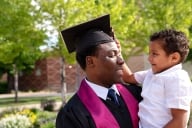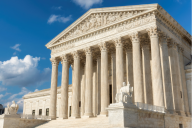You have /5 articles left.
Sign up for a free account or log in.
I was animated, eyes darting from box to box, telling my students how ideologies like white supremacy shape not just what we think but also how we actually read people and situations as well as written texts. “For example,” I continued, “Jacob Blake, an unarmed Black man, was seen as a threat and shot seven times in the back. But several days later, Kyle Rittenhouse, a white man carrying an assault weapon and claiming to have killed someone, was not seen as a threat and went home.”
I had assigned the chapter on “Ideology” from The Theory Toolbox by Jeffrey Nealon and Susan Searles Giroux, and I was preparing my students to make sense of how white supremacy created a funhouse of distortion even in the finest of minds, as we saw next in a selection from Thomas Jefferson’s Notes on the State of Virginia. At our small college, most of our courses are basic surveys, and I use The Theory Toolbox to introduce students to complicated concepts like ideology. And racism is a complicated form of ideology.
Little did I know that a parent was listening in and recording my lecture. The parent then called the president of my college and charged me with bringing “politics” into my American and African American literature courses. The president contacted the vice president of academic affairs, who then contacted the dean of the school of arts and sciences, who then requested to meet with me about the content of my courses. Sensing trouble, I requested to have the faculty council president at the meeting.
In the meeting, the dean described what happened. He agreed that my lecture was in line with my pedagogical objectives. When he asked me what I thought about the situation, I pointed out that if the student had a problem, they should have come to me first, then the chair, then the dean, then the associate dean of academic services. This process is clearly articulated in both the Faculty Handbook and the Student Handbook, and it is covered in the first-year experience orientation sessions. “But what if the student feels intimidated?” the dean asked.
Having spent my entire life in white spaces making my Blackness as nonthreatening as possible, I could not ignore the excess of this response to any threat I could have posed. Additionally, I had not been aware that anyone was recording the class, which was a violation of my class policy. In short, I said, the president’s office should never have accepted this complaint, so the question for me was why had they carried it as far as they did? What were they really telling me?
When my institution went online this past fall, I knew that we can never know who is listening in on our Zoom lectures. I kept telling myself, my friends and my colleagues not to expect anything like privacy in online education. From the for-profit learning management systems (Zoom, Moodle, Blackboard and so forth) to unseen audiences sitting offscreen, I said teaching classes online is like teaching in the focus group room of an advertising agency -- which is especially risky when the one who is professing is Black. I thought about making all of my classes asynchronous and making them as uncontroversial as possible but decided I would be depriving my “frequent fliers” -- as I call students who choose my courses to fill their electives semester after semester -- of my best effort and punishing myself to boot. After all these years of pushing students to challenge the status quo, I had to demonstrate the courage of my convictions.
When the dean filed his written report on the incident, he insisted that he and the administration supported my academic freedom and suggested that the parent had violated college policy in reporting me. What the administration said was reassuring. However, the mere fact that my dean and the administration still felt the need to officially meet with me and to file a written account of the incident raised a couple of concerns.
No Obligation
Unlike the controlled environments of physical classrooms, online education can directly expose those of us doing antiracist work to unintended and hostile audiences. That may be especially perilous at a time soon after the former president of the United States explicitly labeled our work “un-American,” echoing Senator Joseph McCarthy in the 1950s, and a number of current legislators in Congress hold similar views. Some of those audience members are powerful, if only when it comes to our specific institutions, and the incident at my college with the parent proved that some administrators will respond to such complaints, even if unwarranted. So what the administration did -- versus what it said -- alarmed me.
Most colleges and universities are committed to multicultural interpretations of social justice, as long as it also serves the professional interests of white faculty and students. But it remains to be seen if this commitment will extend to an active antiracism. The former is a type of interest convergence, and it lends itself quite easily and naturally to professionalization and can be broken down into assessable skills that can be marketed to corporations and educational administrators without much disruption of the status quo. But the latter, informed by critical race theory, openly questions professionalization as such and demands interrogation and reorganization of the status quo -- precisely because the professions and their educational tributaries are rooted in systemic racism.
While antiracist pedagogy may sharpen skills that many employers seek, such as literacy in a diversity of perspectives and cultures, that is not its primary goal. On the contrary, it aims to reassess its assessors by understanding white supremacy as a key organizing principle of Western history, culture(s) and institutions. It then reimagines them, recognizing the violence that made them possible and then demanding that those long denied agency have full participation.
If institutions of higher education affirm that antiracism is an approach likely to improve the quality of life for most people, advance the production of knowledge and improve the nation’s standing among other nations in the world, then it is no longer tenable to memorialize a time when campuses were mostly white and male and view the question of whether Black people and women should be treated as equals as a matter of opinion. The fact that research and evidence tends not to uphold arguments made by conservatives (and especially reactionaries) and affirms liberal arguments is not due to political bias; it is due to the fact that conservative positions do not fare well under academic scrutiny from a wide range of perspectives.
Therefore, higher education institutions have no more obligation to accommodate the feelings of those opposed to antiracism than they are obliged to accommodate the feelings of those opposed to the theory of evolution or the reality of climate change. The only reason we are compelled to take these ideas seriously is because of the pervasive anti-intellectualism in American life and a conservative bias among those with significant political, social and economic power.
Antiracism has powerful enemies. When he was president, Donald Trump signed an executive order effectively banning diversity and inclusion efforts based on antiracism. And even though Trump has now left office, organizations like Turning Point USA, with its Professor Watchlist, continue the campaign to discredit scholars who advocate antiracism. Some students, faculty members and administrators at my institution have said that the antiracism I advocate is itself "racist" and divisive because it names whiteness. Many powerful people associated with the college seem to feel this way and to have no problem pressuring the administration to silence "radical" professors like myself.
As I stood before my own computer in my own living room reminding my dean that I teach exactly what I was hired to teach, I thought about a blog post I had published a little over three months before that. At the end of it, I equated the culture of my institution with Amy Cooper, the white woman who called the police on a Black bird watcher in Central Park after he asked her to put her dog on a leash. Even though she was the one violating the rules, she was confident she would still get the benefit of the doubt. At the time, I wondered if that was a little over-the-top, but it turned out to be prescient.








